
NON-MINOLTA 35mm ROKKOR-MOUNT SLR CAMERAS

There are LOTS of cameras that can use Minolta SLR lenses but not all were made by Minolta. They run the gamut from non-metered, manual cameras to auto-exposure, motor-driven cameras. Most, but not all, were made in China by a company named Seagull. For the first few years after the Communist Government established itself in China in 1949, private enterprise was allowed to operate as before. Then the government departments gradually increased their involvement in these enterprises, in some cases buying out some of their shares, and later on they were all nationalized (and given really bland names). While different concerns shared the same "Seagull" trademark on their products, it is likely that they were still in a sense separate corporate identities under the umbrella of some government department. (The Seagull company, as we know it today, may have a portion that is no longer owned by the government.) The relationship between Seagull and Minolta is interesting. Seagull has manufactured many types of cameras and liked to put a type number on each camera category, such as "58" for Leica derivatives, "4" for 6X6 twin-lens reflex, etc. For 35mm SLR cameras, Seagull called their camera the "DF". The prototype had a Leica thread, like many Russian cameras of the time, but the production model sported a Minolta mount. Various DF models followed, and Minolta did not seem to be too peeved at all, and even got together with Seagull in 1986 to manufacture the X-300. Although the DF was developed at Seagull, it was also a common practice in China to have resource and model sharing, so it was also built by other Chinese manufacturers under other names. It was built as the Peafowl DF-1, Panda DF-1, and the Zhujiang S-201 (with interchangeable finder) in Harbin, and elsewhere as well. Seagull also used the same chassis for the DFAB, DFB, and DFC recording cameras. Please contact us if you have additional information to add to this list.
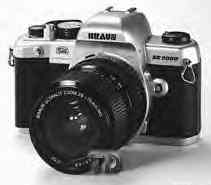
(2000) Same as the Phenix DC901 and made by Phenix. Nice, well-made camera with two special features. First, it has speeds of B, 1 - 1/2000. It also has a super-easy multiple exposure button which naturally falls under your second finger. It also has TTL metering with ISO setting from 25 - 3200. Flash synch is at a fast 1/125. Manual exposure mode only using three red and green LED's in the viewvfinder. The top LED is a red +, while the bottom LED is a red -. A green LED will light in the middle if the exposure is correct by adjusting the shutter speed or f-stop. It's fast and simple, but their is no exposure display of the shutter speed or the f-stop in the viewfinder. The viefinder does sport a 45 degree split-image rangefinder, as well as the microprism collar. The camera also has a stop down button, self-timer, hot shoe and X-synch plug. No motor-drive option. Normally seen with 28-70mm (f3.4-4.8) zoom lens. Also sold with a Pentax K mount. The body is available in champagne silver or black plastic.
This is a Seagull DF-300 sold in France.
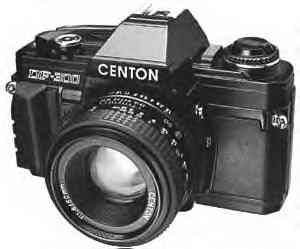
This is a Seagull DF-300 sold by Jessop camera stores in the UK.
The Huaxi S-80 was produced by a defense industry factory located in southwesteren China. Their first successful product was the Pearl River S-201. They were not allowed to label their product "Pearl River" after a Trade Mark Law settlement. The name "Pearl River" now belongs to the Guangdong Photo Equipment Company. So they chose "Huaxi" which means "Western", for their location. They developed an improved model of the Pearl River S-201 and called it Huaxi S-80. Like its ancestor, it uses Minolta lenses, but has a variation on the Minolta mount. It is not a Nikon clone, like the Pearl River S-201, although it has the same basic features. It had a mechanical shutter (1 second to 1/1000), plus B and 1/60 flash synch. It has a fixed pentaprism with a hot shoe. I guess this is why it lacks a PC connection. It's normally seen with a 50mm f2.0 lens -- designed to look like a Pentax K lens -- but other lenses were made, such as a 35-70mm zoom! All of these lenses have the focusing and f-stop ring move in the opposite direction from the normal Minolta mount, but this is not an obstacle to their use since the lenses are all non-MC. It seems it was designed in the late of 1980's and went to market in the early of 1990's. Sales were so lackluster, due to competition from domestic and imported cameras, that production was halted and very few Huaxi S-80 cameras were produced.
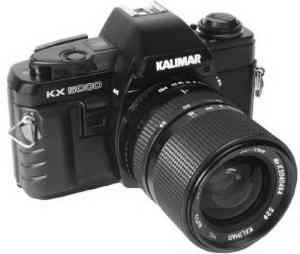
Made by Seagull. It has the body of the Minolta X-370n and looks suspiciously like a Seagull DF-500. Often seen with a 35-70mm f3.5 Kalimar lens. Also seen with a Pentax K mount instead of the Minolta mount. What's interesting about this camera is that it has the features of the X-370 minus the auto-exposure feature. It is a strictly metered-manual exposure camera. It has three LED's in the viewfinder which indicate the correct exposure as you manually change the shutter speed and aperture. Think of it as an SRT in an X-370 body! Same as the Seagull DF-2000, and Phoenix P2000.
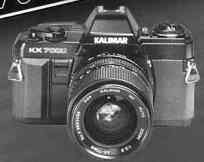
Made by Seagull. Exact licensed replica of the Minolta X-370n. Looks suspiciously like a Seagull DF-1000. Please contact us if you have details on this camera.
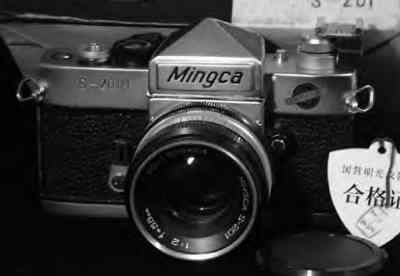
This is an updated version of the Pearl River S-201. It was undoubtedly made by the same factory that made the Pearl River, after they lost the right to use the name, "Pearl River". It lacks the mirror lockup feature and the FP flash connection of the original, but has an improved focusing screen with an unusual, oblong, microprism collar around a 45 degree, split-image rangefinder. In addition, the shutter has been updated. The speeds are the same, except that the flash synch is increased from 1/45 to 1/60. Also, the numbers on the shutter speed scale are larger and easier to read. A bright, red, shutter speed alignment dot has been added for convenience. Last, but not least, the cheap, plastic leatherette has been updated with a solid, almost sticky, rubbery covering. It looks the same as the old leatherette, but the camera feels less likely to slip out of your hands.

(1972) Very similar to the Seagull DF-1.
(1977) This camera is often listed as a Chinese copy of the Minolta SRT101. Superficially it looks the same, but in fact it is substantially different. It is a strictly manual camera shutter speeds from 1 - 1/1000, plus B. Flash synch is at 1/40 with a special setting. Diagonally set rangefinder focusing. Had a silk focal-plane shutter, cable release connection, tripod socket, mirror lockup, self-timer and hot flash shoe. Unlike the SRT series, it lacked a meter. Normally seen with a 58mm f2.0 lens. Came in black and chrome versions. Very similar to the Seagull DF-1.

(1973) Here's an odd one. This camera was produced by a defence industry factory located in southwesteren China. Underneath it's a DF-1 -- the body shell looks like a Minolta SR2 -- but it has been modified to resemble a Nikon F. It had a mechanical shutter (1 second to 1/1000) and 1/60 flash synch. The differences are that its pentaprism finder is removeable -- it looked like the Nikon F's finder -- and it had a Nikon F series-like flash mount shoe at the rewind clank. Normally seen with a 50mm f2.0 lens -- designed to look like a Nikkor lens! The camera is not inscribed "Pearl River", but that is the English translation of the Chinese symbols. Consequently, the same camera is often listed as the Zhujiang S-201, which means "Pearl (Zhu) River (Jiang)".
Available in several lens mounts, such as Minolta, Pentax-K and Universal. Speeds of 1 - 1/2000. Possibly made by Pearl River. Please contact us if you have details on this camera.

Shutter speeds of 1 - 1/1000 sec, plus "B". Metering is center-weighted and exposure is Automatic. Flash synch is at 1/125 sec.
Like the DC700 but with multiple exposure capability.
Like the DC701 but with a little more. Nice, well-made camera with two special features. First, it has speeds of B, 1 - 1/2000. It also has a super-easy multiple exposure button which naturally falls under your second finger. It also has TTL metering with ISO setting from 25 - 3200. Flash synch is at a fast 1/125. Manual exposure mode only using three red and green LED's in the viewvfinder. The top LED is a red +, while the bottom LED is a red -. A green LED will light in the middle if the exposure is correct by adjusting the shutter speed or f-stop. It's fast and simple, but their is no exposure display of the shutter speed or the f-stop in the viewfinder. The viefinder does sport a 45 degree split-image rangefinder, as well as the microprism collar. The camera also has a stop down button, self-timer, hot shoe and X-synch plug. No motor-drive option. Normally seen with 28-70mm (f3.4-4.8) zoom lens. Also sold with a Pentax K mount. The body is available in champagne silver or black plastic.Same as the Braun SR2000.
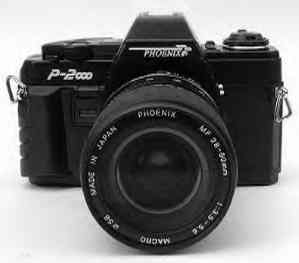
A X-370 stripped-down clone in terms of the camera body, but this is strictly a manual exposure camera. It has a built-in TTL meter, but it lacks the auto-exposure of the X-370. In addition, it will not acccept a motror drive. Often seen with a Phoenix 28-80 f3.5/5.6 zoom lens. Same as the Seagull DF-99 and Kalimar KX 5000.
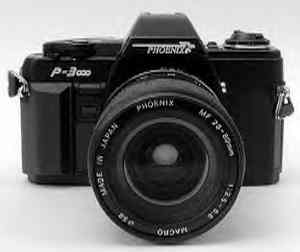
A X-370 clone.
It's really the same thing as the Seagull DF5000. The only difference is that it is marked Phoenix P5000, and not marked "Colani" on the back. A future K mount version is planned, supposedly. We'll see if that happens. Since this is a high end camera, its conversion might depend on sales.

(1964) The prototype of this camera was fitted with a 39mm leica screw mount, but the production model had a Minolta mount. This camera is often listed as a Chinese copy of the Minolta SRT101 of 1966. In reality, it more like a variant of the earlier Minolta SR cameras. Superficially it looks the same as the SRT101, but internally it is substantially different. Although it has some similarities with the SRT101 such as shutter speeds from 1 - 1/1000, plus B, cold flash shoe and a mirror lockup, it is a strictly manual camera. It does not have a meter -- like the SRT101. Unlike the SRT101, it has a round viewfinder -- like the early Minolta SR cameras, not to mention the plain screen for viewing -- no microprism like the SRT101. In addition, it has both FP and X connections for flash and it even has connections on the bottom for a motor drive. This may sound odd, but since the design for this camera was copied from the Minolta SR (which originally had a motor drive connection) it makes sense. Perhaps this explains the mirror lockup as well, which was never used by any Seagull lenses. Perhaps they copied features directly without regard to utility. All versions of the DF come with the Seagull icon on the top of the prism and the SEAGULL name below the shutter release. Most versions are seen with two Chinese characters on the faceplate above the lens, but exported models have a metallic decal covering these characters which says "REFLEX DF". Normally seen with a 58mm f2.0 lens.

(1966) This was an updated version of the original DF. The most obvious change is the movement of the Seagull name to the front nameplate directly above the lens. The main advantage is that this model has a hot shoe and plastic tip on the film advance lever. Other changes were the move from a round to a square viewfinder -- although the Minolta square viewfinder accessories will not fit on this new viewfinder. There were a few features removed from this model, as well. For example, the FP flash connection and motor drive connection have been removed. No mirror lockup. The focusing screen was improved, and is just like the Minolta SRT102. All other features are the same -- flash synch is at 1/40 with a special setting, cloth focal-plane shutter, cable release connection, tripod socket, self-timer. Normally seen with a 58mm f2.0 lens. Came in black and chrome versions.

(1981) This camera is often listed as an updated version of the DF-1. Initially it was intended to include a TTL meter, but this feature was dropped from the production model. As a result, The DF-2 is basically the same camera as the DF-1 with a more stylish appearance and more plastic parts. It weighs quite a bit less than the DF-1. The exterior of the body is now plastic, but good quality plastic. Even the leatherette is now plastic. Otherwise all features are the same as the DF-1. Normally seen with a 50mm f1.8 lens. Came in black and chrome versions.
An improved version of the DF-1 with a built-in center-weighted meter. Other features the same.

An improved version of the DF-2 with a built-in center-weighted meter. Other features the same.
Very similar to the Seagull DF-99.
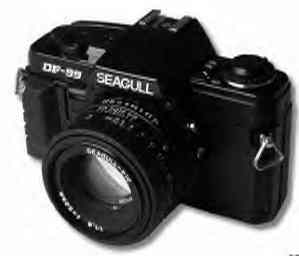
A X-370 stripped-down clone in terms of the camera body, but this is strictly a manual exposure camera. It has a built-in TTL meter, but it lacks the auto-exposure of the X-370. In addition, it will not acccept a motror drive. Same as the Phoenix P-2000 and Kalimar KX 5000.

I'll never know why they didn't call this the Seagull DF- 2000 or something
like that, since it has a top speed of 1/2,000. It is strictly a mecahnical
camera and doesn't even have a meter, but if you don't need that feature,
this is a great camera. If you need a meter, get a Seagull DF-200, Braun
SR-2000, or Phenix DC-901.

A step up from the DF-100, this model adds a meter. The meter is pretty basic
but works well. It has three LED's for OVER, UNDER and OK. It is stirctly
a manual meter and no automatic exposure is available. The vertical-travel
shutter is completely manual and does not need a battery. SO if the
meter dies, or the battery is dead, or the meter is not turned on, the camera
can still take a picture.


Variant of the DF-300A

Manual exposure only variant of the DF-300A with a built-in center-weighted meter. Shutter speeds from 1 - 1/1000, plus B. No X-type flash connection -- not as in X-synch, but it lacks the extra X-flash connection on the flash shoe.
Based on the DF-300 but with multiple-exposure and DOF preview.

Yet another variation of the DF-300.
Based on the DF-300G but with a different body style.
No, this isn't a Minolta XD clone. It is just another variant of the Minolta X-370. This one comes with a databack, however.







The body was designed by Luigi Colani, but it's just a DF-300 with a stylized
covering. It has a quartz-control, horizontal travel cloth focal-plane
shutter, aperture-priority, automatic exposure and match-LED metered-manual
mode. Acute matte focusing screen with central split-image spot surrounded
by microprism band and TTL center-weighted average metering (CDS cell).
ISO 12-3200 set by film-speed dial that locks at 1/3 EV increments. AE lock,
electronic self-timer for 10 sec delay (with operation indicated by LED
blinking). Stepless speeds from 4 seconds to 1/1000 sec. in AUTO mode
-- or fixed speeds of 1 second to 1/1000 sec and "B" in MANUAL mode.
"X" sync at 1/60 sec. and lower. Usesd two 1.5V(LR44) batteries. An
beeping alarm for self-timer and the exposure of lower speed. It has
TTL auto flash SYNC. Supposedly available in chrome or black, but the
chrome version may just have been a pre-production model. A custom,
stylish power-winder is available, but any G winder will work.

Looks suspiciously like a Hanimex KX5000. Probably made by Seagull. Soligor makes a variety of lenses to fit this camera -- and any Minolta camera.
X370 clone often sold with a Zoom 28-70 (f3.5-4.5). Probably made by Seagull apparently for the Japanese market. It has a horizontally-moving cloth focal plane shutter. 4 seconds to 1/1000 in Auto mode. 1 second to 1/1000 in Manual mode. Bulb and flash synch is 1/60. Electrically controlLED self timer (10 seconds before shutter release). In self-timer mode, LED on a front of a body blinks. The finder has split and micro prism along with shutter speed scale and LED indication. Over or under exposure indication. Flash full chaged indication.(In manual mode, match LEDs type like X370s.) Exposure mechanism is an SPD light sensor. Center weighted type. TTL AE and manual exp. mode. Light sensor sensitivity is EV1 to 18 at ISO100 and F1.4 lens. AE lock button. ISO range is 12-3200, set manually. Batteries: two LR44 or SR44 Or CR1/3N litium battery.
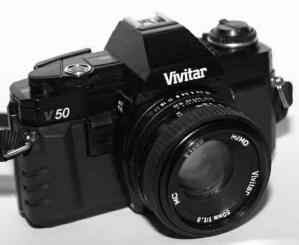
A X-370 clone. Usually seen with a 50mm f1.8 Vivitar lens. Same as the Soligor SR-300 MD and Seagull DF-300A. Vivitar makes a variety of lenses to fit this camera -- and any Minolta camera.
See the Pearl River S 201
The material on this website is protected by US Federal copyright laws. It cannot be copied or used in any manner without specific approval from the owner.